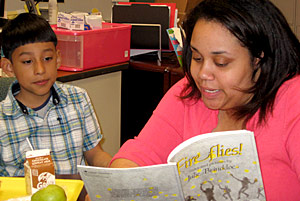Reading
Reading targets by grade level
 The Reading Targets chart shows the target reading level for each quarter of the instructional year. Prekindergarten through Grade 5 students are expected to meet or exceed these levels in order to assure adequate progress toward reading proficiency.
The Reading Targets chart shows the target reading level for each quarter of the instructional year. Prekindergarten through Grade 5 students are expected to meet or exceed these levels in order to assure adequate progress toward reading proficiency.
- Reading targets chart (PDF) (Posted 11/06/2017)
- Find out more about the reading curriculum with the Parent Guides to the Curriculum for Kindergarten through Grade 1
The process of reading
Reading is the process of constructing meaning from written text. It is a complex skill requiring the coordination of a number of interrelated sources of information. Reading is based upon five principles:
- Reading is a constructive process.
- Reading must be fluent.
- Reading must be strategic.
- Reading requires motivation.
- Reading is a continuously developing process.
Reading involves the interrelatedness of the five components of reading: phonemic awareness, phonics, fluency, vocabulary, and comprehension. It is an interactive process in which students construct and extend meaning from life’s experiences, language, print, and non-print materials. Students read for literary experiences, to gain information, and to perform tasks.
Students read for a variety of purposes: Reading for a Literary Experience involves reading stories, plays, or poems; Reading To Be Informed involves reading informational text, articles, resource material, and procedural material. Reading instruction involves teaching the skills and strategies to decode and comprehend text by helping students develop effective and efficient processing systems. Strategy-based reading instruction provides students with a plan for monitoring and problem-solving difficulties with text before reading, during reading, and after reading. Word study, which includes phonics, structural analysis, and vocabulary study is integral to decoding and constructing meaning. The teacher read-aloud provides a model for good reading, a model for good writing, introduces “book language,” and supports listening and comprehension instruction. The shared reading and guided reading components of balanced literacy provide support as the student becomes more confident in applying skills.